Blockchain technology has changed the way we perceive data management and transaction processing. Its decentralized and secure nature offers a lot of benefits over traditional client-server architectures.
Understanding the basics of blockchain architecture, its components, and its types is essential for grasping its potential applications and advantages.
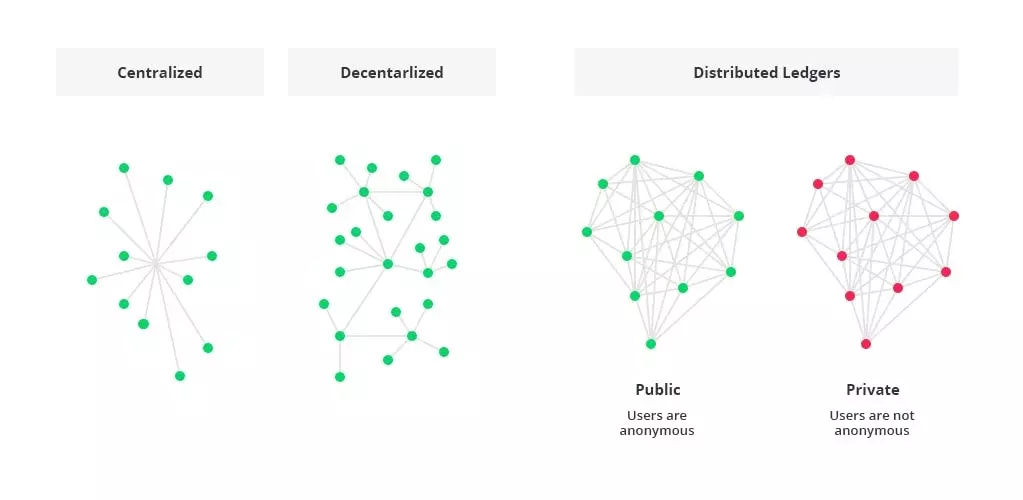
Database vs Blockchain Architecture
The traditional structure of the World Wide Web uses a client-server network. In this case, the server keeps all the required information in one place for easy updates. The server acts as a centralized database controlled by some administrators with permissions.
In the case of the distributed network of blockchain architecture, each participant within the network maintains, approves, and updates new entries. The system is controlled not only by separate individuals but by everyone within the blockchain network. Each member ensures that all records and procedures are in order, which results in data validity and security.
Thus, parties that do not necessarily trust each other can reach a common consensus.
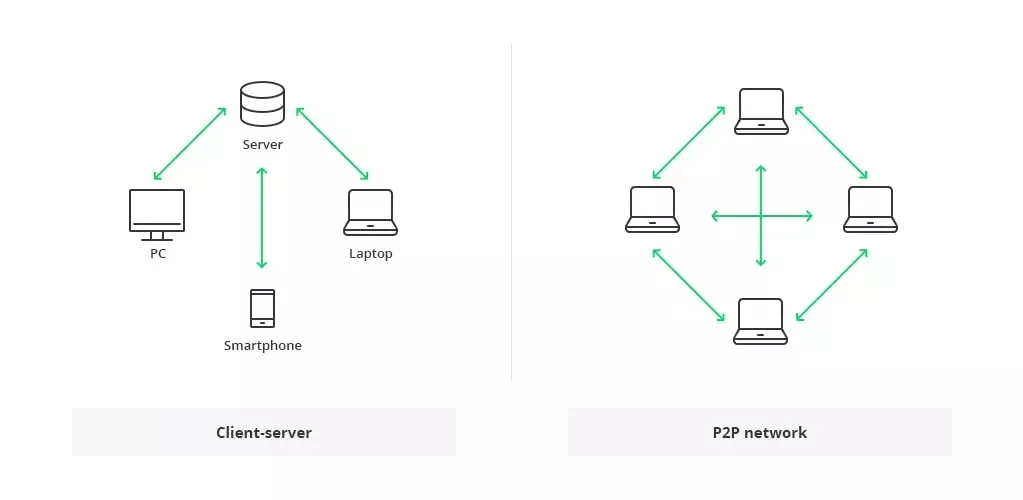
While client-server networks centralize data management, blockchain utilizes a peer-to-peer (P2P) network where each participant maintains a copy of the ledger. This decentralized approach fosters trust and eliminates the need for intermediaries.
Key Characteristics of Blockchain Architecture
Blockchain structures vary, including public, private, and consortium types, each tailored to specific organizational needs and privacy requirements. Public blockchains like Bitcoin are open to all, while private blockchains restrict access to authorized users.
Blockchain architecture boasts key features like cryptography, immutability, provenance, decentralization, anonymity, and transparency. These ensure data integrity, security, and trust across various applications
Blockchain architecture can serve the following purposes for organizations and enterprises:
-
Cost reduction - Significant expenditures are allocated to maintaining centrally held databases, such as those utilized by banks and governmental institutions, to ensure data currency and safeguard against cyber threats and corruption.
-
Data history - In a blockchain framework, users can access the complete history of any transaction at any given moment. Unlike a centralized database which offers a static snapshot, blockchain maintains an ever-growing archive of transactional data.
Data integrity & security - Once data is entered into a blockchain, it becomes highly resistant to tampering due to the inherent nature of the technology. Verification of records occurs independently across multiple nodes, sacrificing processing speed for enhanced data security and validity assurance.
Types of Blockchain Architecture Explained
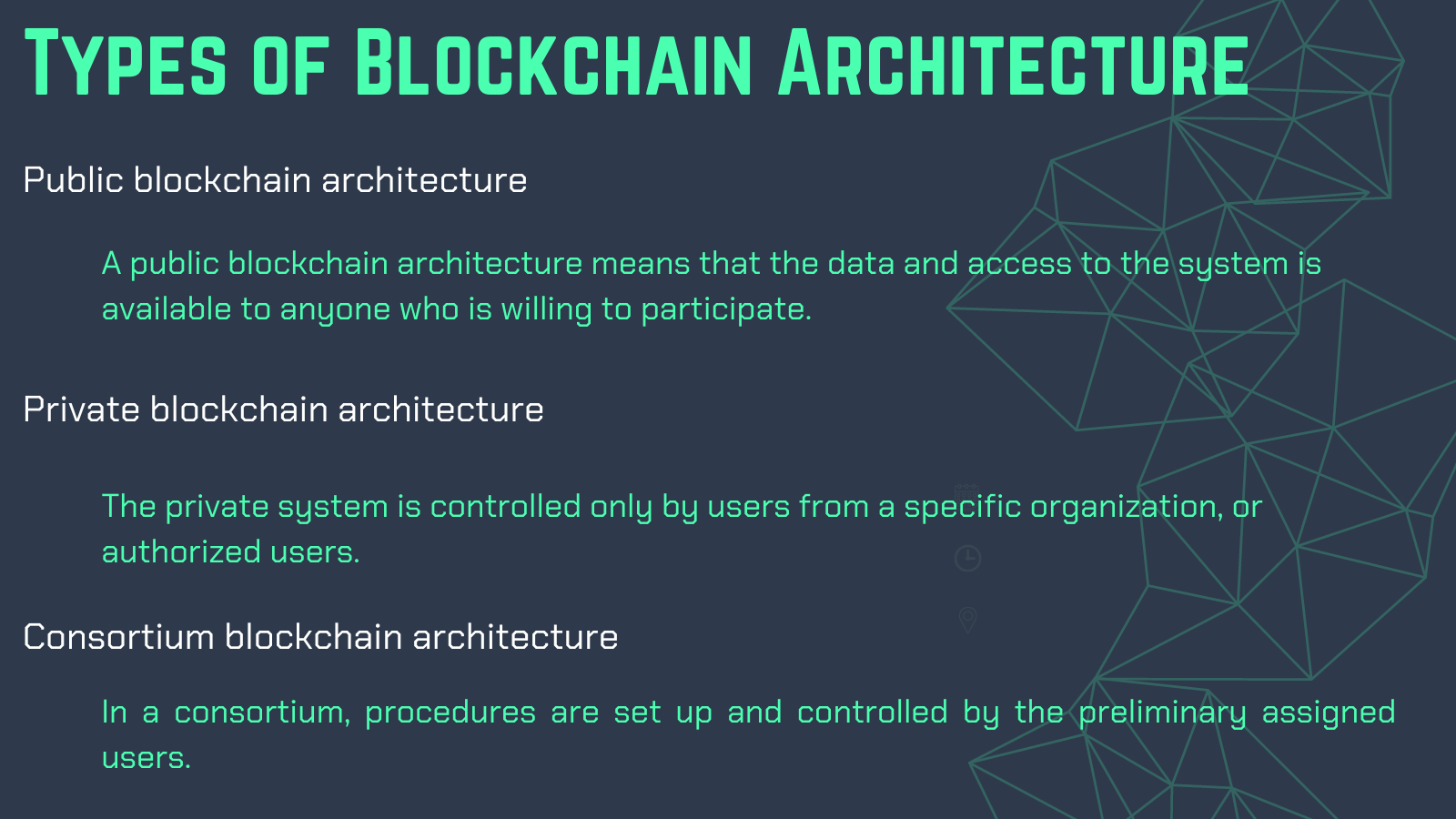
- Public Blockchain Architecture
A public blockchain architecture means that the data and access to the system are available to anyone willing to participate (e.g. Bitcoin, Ethereum, and Litecoin blockchain systems are public).
- Private Blockchain Architecture
As opposed to public blockchain architecture, the private system is controlled only by users from a specific organization, or authorized users who have an invitation for participation.
- Consortium Blockchain Architecture
This blockchain structure can consist of a few organizations. In a consortium, procedures are set up and controlled by the preliminary assigned users.
Comparative Analysis of Public, Consortium, and Private Blockchain Systems
The comparison among public, consortium, and private blockchain systems reveals different characteristics across various properties.
-
In terms of consensus determination, public blockchains rely on all miners to reach agreement, while consortium blockchains involve a selected set of nodes and private blockchains operate within a single organization's control.
-
Regarding read permissions, public blockchains offer unrestricted access, while consortium and private blockchains may have either public or restricted access.
-
Immunity to tampering varies, with public blockchains being almost impossible to tamper with, while consortium and private blockchains could be susceptible.
-
Efficiency in resource usage is notably higher in consortium and private blockchains compared to public ones, which typically consume more resources.
-
Centralization levels vary, with public blockchains being decentralized, consortium blockchains being partially centralized, and private blockchains being fully centralized.
-
Consensus processes also differ, with public blockchains being permissionless, while consortium and private blockchains require permission for participation.
Core Elements of Blockchain Technology
As mentioned, blockchain serves as a distributed ledger where each participant maintains a local copy. However, the degree of centralization or decentralization within a blockchain system varies depending on its structure and context, particularly regarding who controls the ledger.
A private blockchain tends to be more centralized as it's governed by a specific group, offering enhanced privacy. Conversely, public blockchains are decentralized, allowing open participation.
In a public blockchain, all records are visible to anyone, and participation in the consensus process is open. However, this openness results in less efficiency due to the time required to validate each new record.
Regarding efficiency, transaction times in public blockchains are less eco-friendly due to the significant computational power required compared to private blockchain architectures.
Every new record or transaction in a blockchain necessitates the creation of a new block. Each record is validated and digitally signed to ensure its authenticity before being added to the network. Verification typically involves the consensus of the majority of nodes in the system.
Let’s break it down further.
- Data Structure and Hashing
Below is a blockchain architecture diagram illustrating this process within a digital wallet.
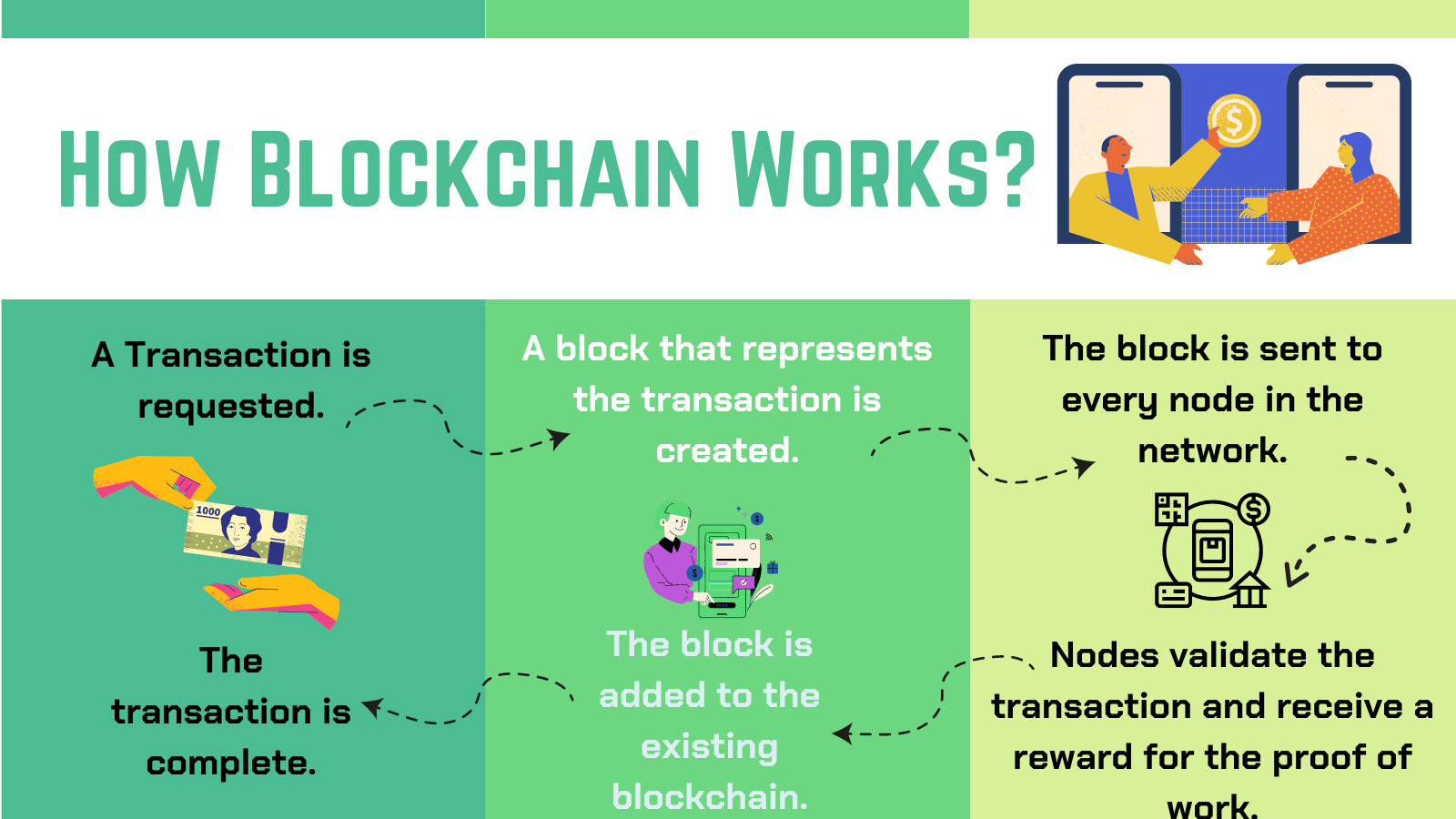
The data stored inside each block depends on the type of blockchain. For instance, in the Bitcoin blockchain structure, the block maintains data about the receiver, sender, and the amount of coins.
A hash is like a fingerprint (a long record of some digits and letters). Each block hash is generated with the help of a cryptographic hash algorithm (SHA 256). Consequently, this helps to identify each block in a blockchain structure easily.
The moment a block is created, it automatically attaches a hash. Any changes made in a block affect the change of a hash too. Simply stated, hashes help to detect any changes in blocks.
The final element within the block is the hash from a previous block. This creates a chain of blocks and is the main element behind blockchain architecture’s security.
As an example, block 45 points to block 46. The very first block in a chain is a bit special - all confirmed and validated blocks are derived from the Genesis block.
- Security Measures
Any corrupt attempts provoke the blocks to change. Every following block then carries incorrect information, rendering the whole blockchain system invalid.
Furthermore, in theory, it could be possible to adjust all the blocks with the help of strong computer processors. However, there is a solution that eliminates this possibility - proof-of-work. This allows a user to slow down the process of creation of new blocks.
In Bitcoin blockchain architecture, it takes around 10 minutes to determine the necessary proof-of-work and add a new block to the chain. This work is done by miners - special nodes within the Bitcoin blockchain structure. Miners get to keep the transaction fees from the block that they verified as a reward.
Each new user (node) joining the peer-to-peer network of blockchain receives a full copy of the system. Once a new block is created, it is sent to each node within the blockchain system.
Then, each node verifies the block and checks whether the information stated there is correct. On verification, the block is added to the local blockchain in each node.
- Consensus Protocol
All nodes within a blockchain architecture contribute to the creation of a consensus protocol, which comprises a set of network rules. Compliance with these rules becomes self-enforced within the blockchain, ensuring integrity and reliability.
For instance, the Bitcoin blockchain adheres to a consensus rule where transaction amounts are halved after every 200,000 blocks. This means that if a block initially rewards 10 BTC for verification, this reward is halved following the specified block interval.
Additionally, Bitcoin's protocol sets a maximum supply of 21 million BTC, with only 4 million BTC remaining to be mined. Once this limit is reached, the production of new Bitcoins halts unless alterations are made to the protocol.
- Immutable and Secure Nature
This inherent structure renders blockchain technology immutable and cryptographically secure by eliminating the need for intermediaries.
Tampering with the blockchain system would necessitate altering every block, recalculating the proof-of-work for each block, and gaining control over more than 50% of the nodes in the peer-to-peer network, making such tampering virtually impossible.
Key Characteristics of Blockchain Architecture
Blockchain architecture possesses a lot of benefits for businesses. Here are several embedded characteristics:
-
Cryptography - Blockchain transactions are validated and trustworthy due to the complex computations and cryptographic proof among involved parties.
-
Immutability - Any records made in a blockchain cannot be changed or deleted.
-
Provenance - It refers to the fact that it is possible to track the origin of every transaction inside the blockchain ledger
-
Decentralization - Each member of the blockchain structure has access to the whole distributed database. As opposed to the central-based system, the consensus algorithm allows for control of the network
-
Anonymity- Each blockchain network participant has a generated address, not a user identity. This keeps users' anonymity, especially in a public blockchain structure
-
Transparency - The blockchain system cannot be corrupted. This is very unlikely to happen, as it requires huge computing power to overwrite the blockchain network completely
Understanding Layers of Blockchain Architecture
The architecture of blockchain is not a monolithic structure but rather a complex stack of multiple layers, each with its distinct role and function.
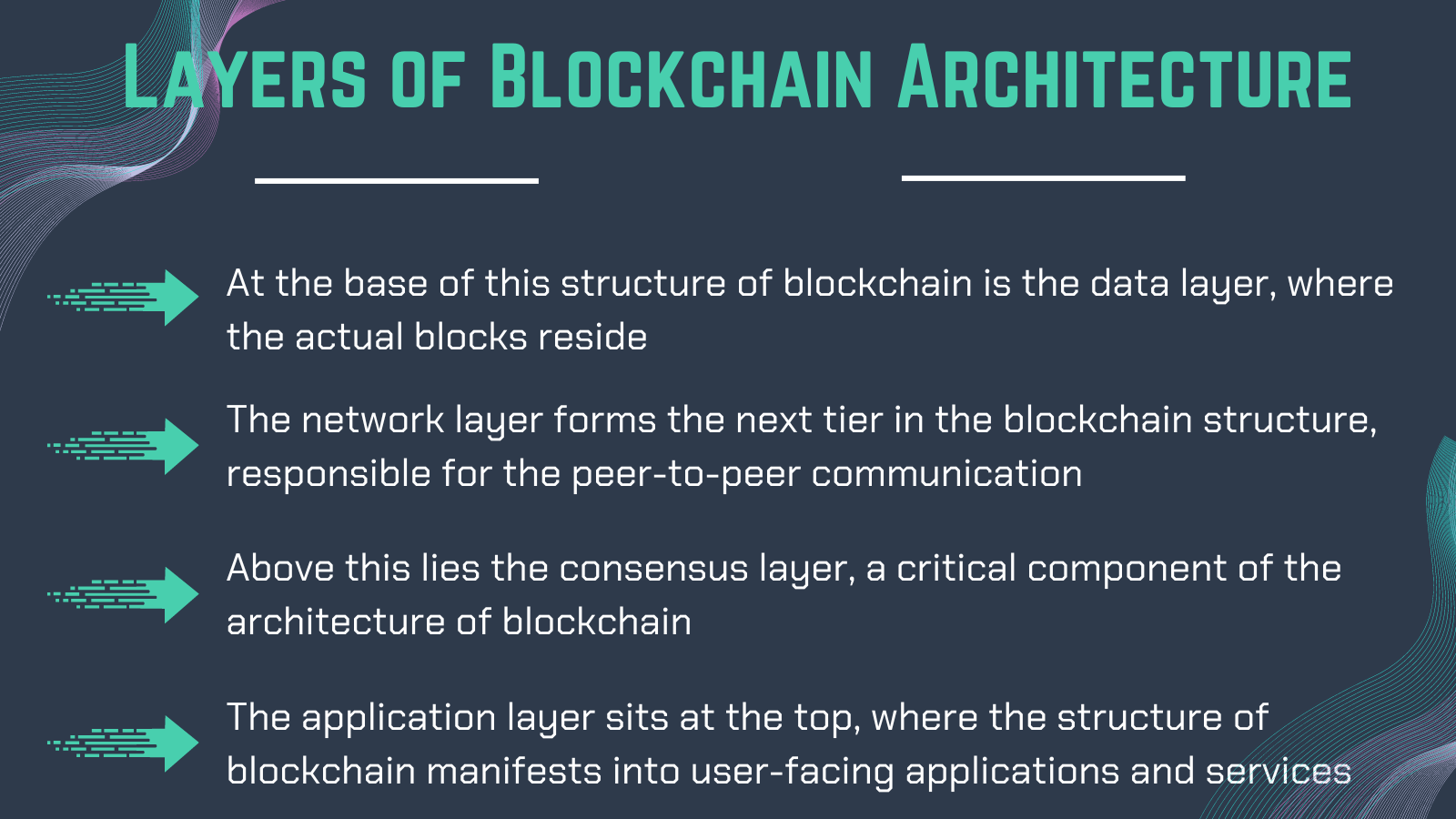
-
At the base of this structure of blockchain is the data layer, where the actual blocks reside, containing transactional information securely linked using cryptographic hashes.
-
The network layer forms the next tier in the blockchain structure, responsible for the peer-to-peer communication essential for distributing information across the network.
-
Above this lies the consensus layer, a critical component of the architecture of blockchain, which ensures that all nodes agree on the state of the ledger, thus maintaining its integrity and trustworthiness.
-
The application layer sits at the top, where the structure of blockchain manifests into user-facing applications and services, making blockchain technology accessible and useful in real-world scenarios.
Understanding these layers is crucial for comprehending the full scope and versatility of blockchain architecture, paving the way for innovative applications that extend beyond cryptocurrencies.
Nodes and Networks
In the blockchain structure, nodes are the fundamental components that uphold the network's integrity and functionality.
A node in the architecture of blockchain is typically a computer connected to the blockchain network, which actively maintains a copy of the entire ledger. This decentralized nature of nodes is what gives the blockchain architecture its strength and resilience.
In a public blockchain structure, anyone can participate as a node, contributing to the network's robustness and security. On the other hand, in a private blockchain architecture, node participation is restricted, offering a more controlled environment.
These nodes play a crucial role in the validation and relay of transactions, forming a peer-to-peer network that is central to the blockchain structure. This setup ensures that the blockchain architecture remains transparent yet secure, as every node in the network works towards achieving consensus, validating transactions, and maintaining an identical copy of the ledger.
Ensuring Security and Trust
A pivotal aspect of blockchain architecture is the mechanism used to achieve consensus among the various nodes in the network. This consensus mechanism is crucial in the structure of blockchain as it ensures all participants agree on the ledger's current state.
In many public blockchains, the proof-of-work system is employed as a part of this consensus process. This system, integral to the architecture of blockchain, requires nodes (or miners) to solve complex mathematical problems, thus validating transactions and creating new blocks.
The proof-of-work model not only secures the blockchain structure but also mitigates the risk of fraudulent transactions and double-spending. It is the backbone of the trust and security that blockchain architecture promises, ensuring that each transaction is accurately recorded and immutable once added to the structure of the block in the blockchain.
Building a Blockchain Architecture
Developing a blockchain network is a meticulous process that forms the backbone of any blockchain architecture. It involves setting up an infrastructure that adheres to the specific requirements of the intended blockchain structure.
Whether it’s a public, private, or consortium blockchain, each type demands a unique approach to network creation. This network is the foundation upon which the structure of the blockchain operates, enabling nodes to interact, transactions to be processed, and consensus mechanisms to be executed.
Key considerations in building a blockchain architecture include-
-
Selecting the right consensus algorithm.
-
Ensuring scalability.
-
Maintaining security protocols.
Tools and platforms, such as Ethereum for public blockchains or Hyperledger for private ones, offer diverse functionalities tailored to different blockchain structures. These tools not only facilitate the creation of a blockchain network but also empower developers to customize the architecture of blockchain to fit specific use cases.
Conclusion
Blockchain architecture signifies a paradigm shift in data management, offering unparalleled security and efficiency. Understanding its components and characteristics empowers organizations to leverage blockchain's potential, revolutionizing industries and processes.
Embracing blockchain is not merely a technological advancement but a strategic narrative for navigating the digital future.